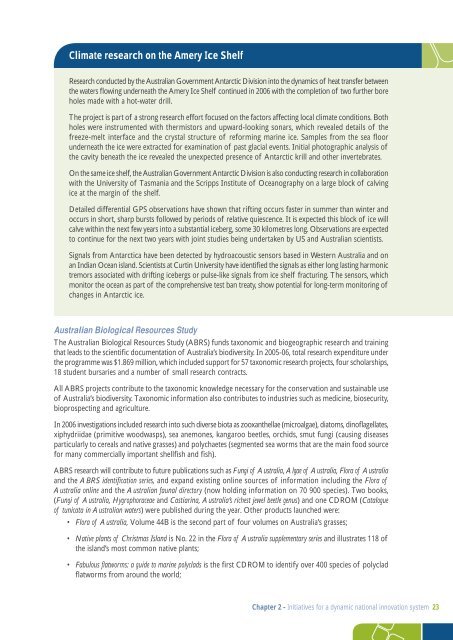The Australian Government's Innovation Report
The Australian Government's Innovation Report
The Australian Government's Innovation Report
You also want an ePaper? Increase the reach of your titles
YUMPU automatically turns print PDFs into web optimized ePapers that Google loves.
Climate research on the Amery Ice Shelf<br />
Research conducted by the <strong>Australian</strong> Government Antarctic Division into the dynamics of heat transfer between<br />
the waters flowing underneath the Amery Ice Shelf continued in 2006 with the completion of two further bore<br />
holes made with a hot-water drill.<br />
<strong>The</strong> project is part of a strong research effort focused on the factors affecting local climate conditions. Both<br />
holes were instrumented with thermistors and upward-looking sonars, which revealed details of the<br />
freeze-melt interface and the crystal structure of reforming marine ice. Samples from the sea floor<br />
underneath the ice were extracted for examination of past glacial events. Initial photographic analysis of<br />
the cavity beneath the ice revealed the unexpected presence of Antarctic krill and other invertebrates.<br />
On the same ice shelf, the <strong>Australian</strong> Government Antarctic Division is also conducting research in collaboration<br />
with the University of Tasmania and the Scripps Institute of Oceanography on a large block of calving<br />
ice at the margin of the shelf.<br />
Detailed differential GPS observations have shown that rifting occurs faster in summer than winter and<br />
occurs in short, sharp bursts followed by periods of relative quiescence. It is expected this block of ice will<br />
calve within the next few years into a substantial iceberg, some 30 kilometres long. Observations are expected<br />
to continue for the next two years with joint studies being undertaken by US and <strong>Australian</strong> scientists.<br />
Signals from Antarctica have been detected by hydroacoustic sensors based in Western Australia and on<br />
an Indian Ocean island. Scientists at Curtin University have identified the signals as either long lasting harmonic<br />
tremors associated with drifting icebergs or pulse-like signals from ice shelf fracturing. <strong>The</strong> sensors, which<br />
monitor the ocean as part of the comprehensive test ban treaty, show potential for long-term monitoring of<br />
changes in Antarctic ice.<br />
<strong>Australian</strong> Biological Resources Study<br />
<strong>The</strong> <strong>Australian</strong> Biological Resources Study (ABRS) funds taxonomic and biogeographic research and training<br />
that leads to the scientific documentation of Australia’s biodiversity. In 2005-06, total research expenditure under<br />
the programme was $1.869 million, which included support for 57 taxonomic research projects, four scholarships,<br />
18 student bursaries and a number of small research contracts.<br />
All ABRS projects contribute to the taxonomic knowledge necessary for the conservation and sustainable use<br />
of Australia’s biodiversity. Taxonomic information also contributes to industries such as medicine, biosecurity,<br />
bioprospecting and agriculture.<br />
In 2006 investigations included research into such diverse biota as zooxanthellae (microalgae), diatoms, dinoflagellates,<br />
xiphydriidae (primitive woodwasps), sea anemones, kangaroo beetles, orchids, smut fungi (causing diseases<br />
particularly to cereals and native grasses) and polychaetes (segmented sea worms that are the main food source<br />
for many commercially important shellfish and fish).<br />
ABRS research will contribute to future publications such as Fungi of Australia, Algae of Australia, Flora of Australia<br />
and the ABRS identifi cation series, and expand existing online sources of information including the Flora of<br />
Australia online and the <strong>Australian</strong> faunal directory (now holding information on 70 900 species). Two books,<br />
(Fungi of Australia, Hygrophoraceae and Castiarina, Australia’s richest jewel beetle genus) and one CDROM (Catalogue<br />
of tunicata in <strong>Australian</strong> waters) were published during the year. Other products launched were:<br />
• Flora of Australia, Volume 44B is the second part of four volumes on Australia’s grasses;<br />
• Native plants of Christmas Island is No. 22 in the Flora of Australia supplementary series and illustrates 118 of<br />
the island’s most common native plants;<br />
• Fabulous fl atworms: a guide to marine polyclads is the first CDROM to identify over 400 species of polyclad<br />
flatworms from around the world;<br />
Chapter 2 - Initiatives for a dynamic national innovation system 23












![[Tam] Uygula[ya] - Bilim, Teknoloji ve Ä°novasyon Politikaları TartıÅma ...](https://img.yumpu.com/36820041/1/184x260/tam-uygulaya-bilim-teknoloji-ve-anovasyon-politikalara-tartaama-.jpg?quality=85)



